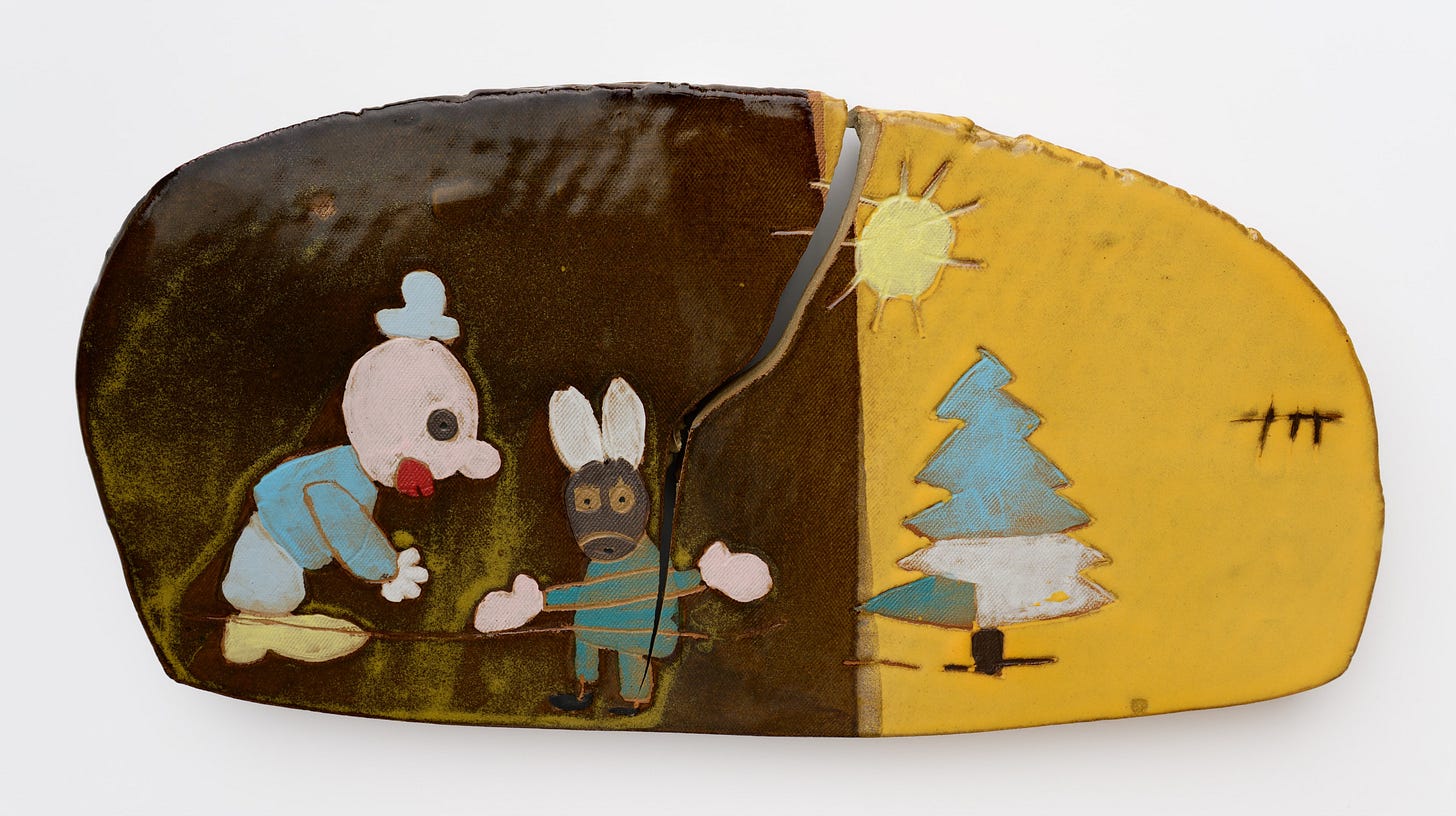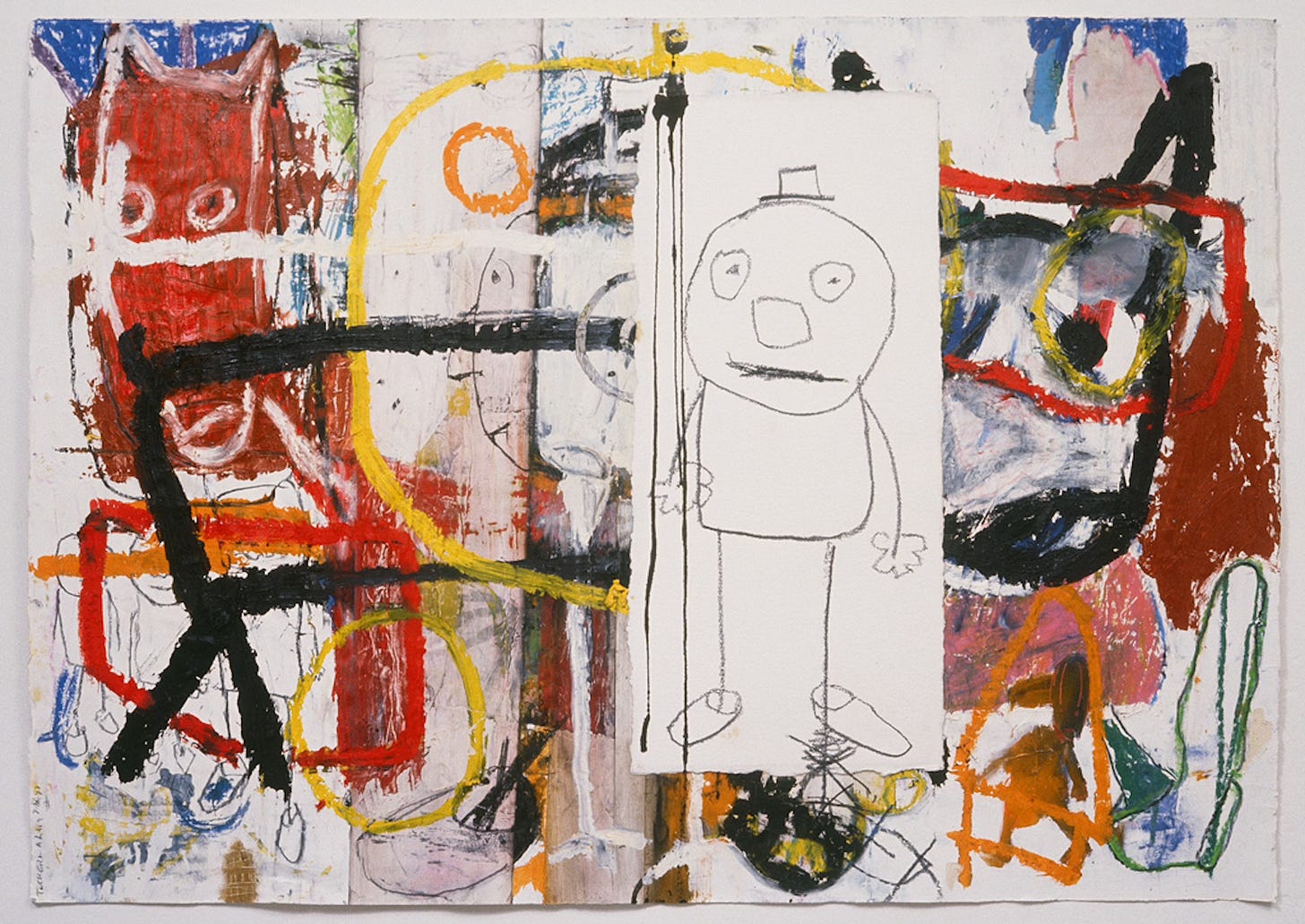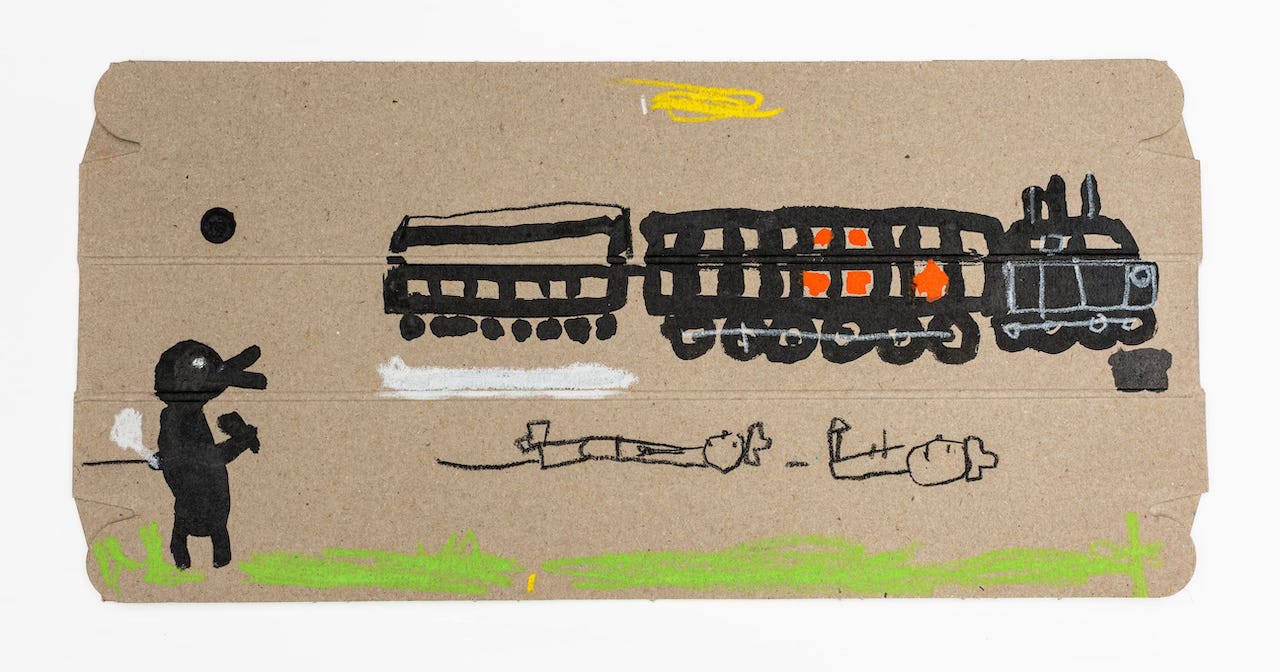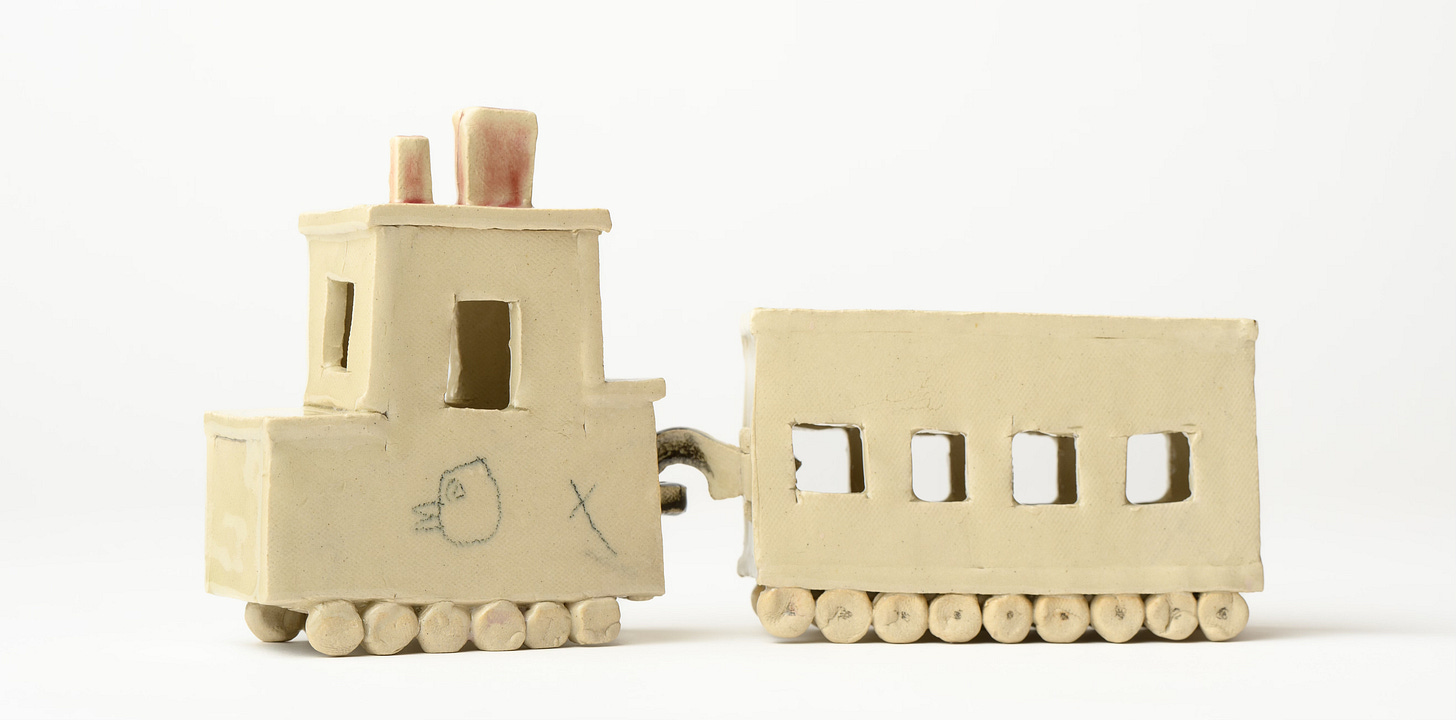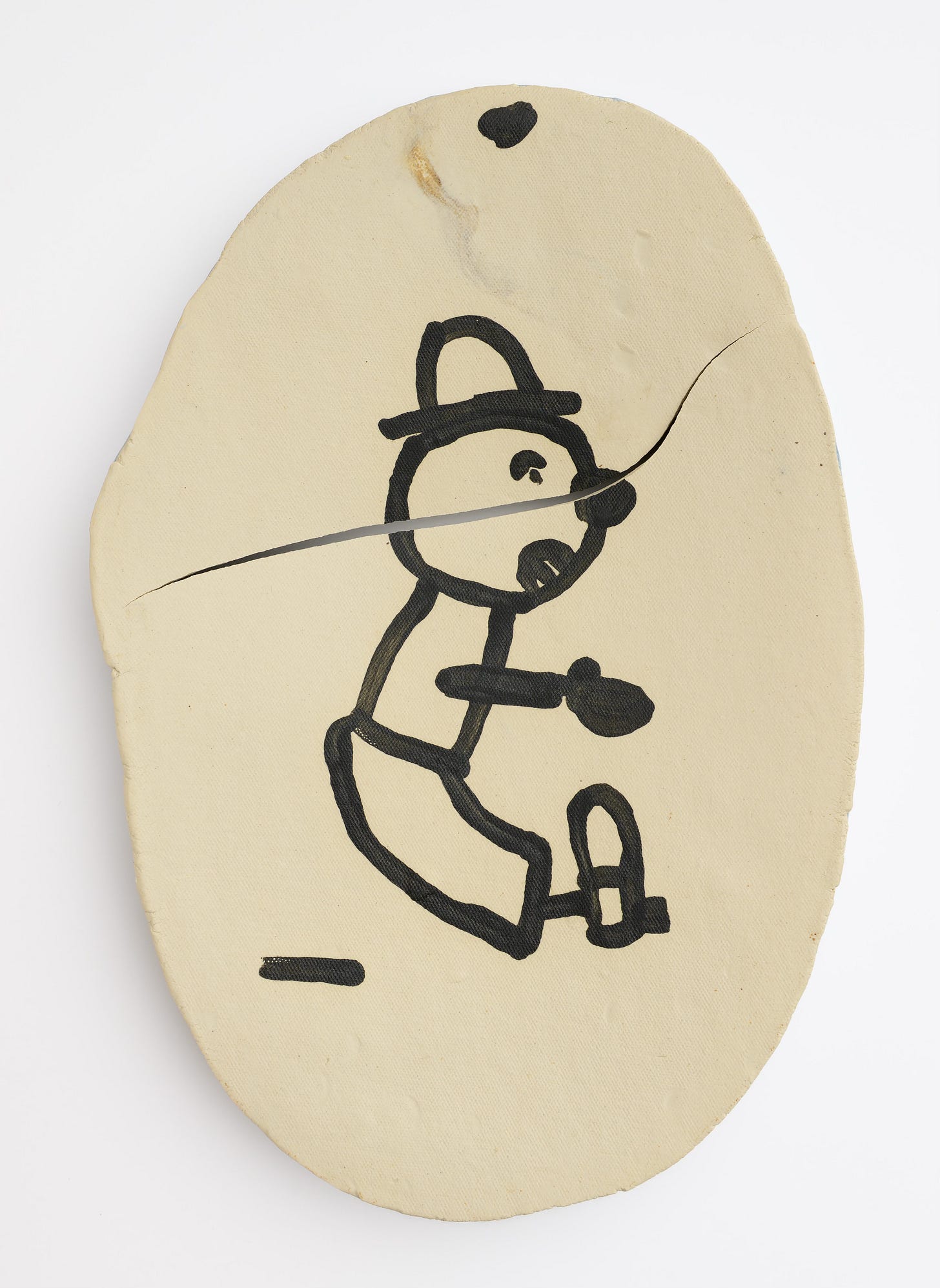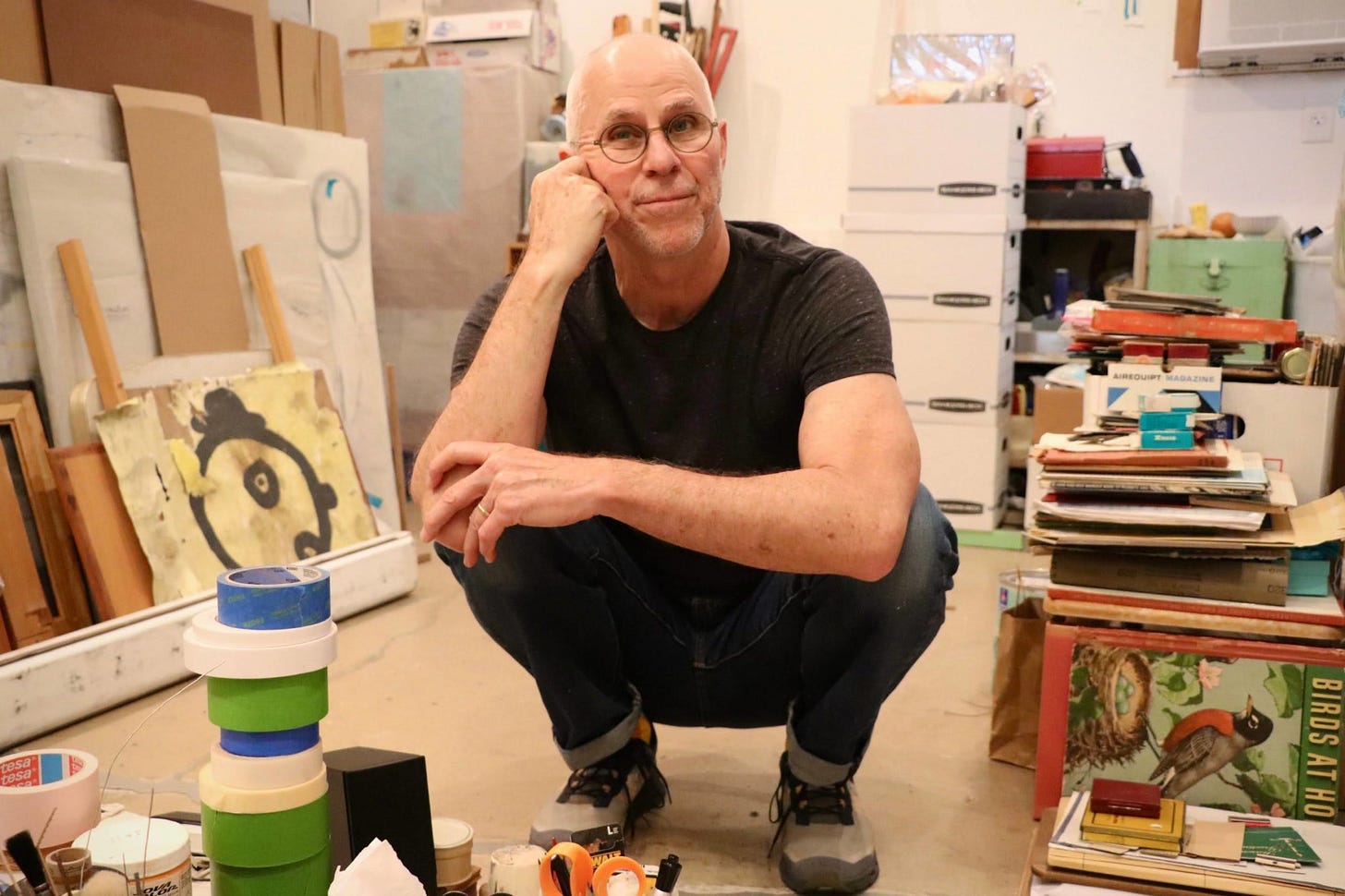this connected to that that connected to this .....
A conversation with Tarantula: Authors and Art's inspiration for September, W. Tucker
A pink wall with an imperfectly shaped head, reminiscent of early cartoons.
The head (character) repeats itself around the gallery in various scenarios. Glossy ceramics recall the playful clumsiness of school art projects: trains, boats, animals. When I stepped into the Hedenius Gallery last May, I felt a rush of joy — here was art that hadn’t forgotten the importance of play.
Play doesn’t care if the line is straight, and W. Tucker, an artist based in Austin, Texas, knows this. He approaches his canvases, often made from unconventional materials, with childlike naivety, refusing to impose rigid ideas upon them. Instead, he begins with marks and lines, losing control as his non-dominant hand wanders across the blank spaces. Characters appear like newborns searching for their place in the world. Sometimes they arrive upside down, broken, or oddly shaped; their gaze just slightly askew. Somehow, in their crookedness, they start to look like us. Like me. Like you.
The whole gallery mirrored this sense of play. Visitors chirped like the little birds perched across his canvases. Tucker himself was open and eager for honest conversation. Suddenly, we were all connected — from dot to dot, from fingertip to fingertip, smile to smile. In a gallery space that so often feels restrained, pretense was dropped. Tucker’s unpolished characters underscored a quiet truth: joy emerges not from perfection, but from the fragile, flawed spaces in which humanity softly rests.
Tarantula: Authors And Art: You have a very specific method when it comes to creating art. Can you tell us a little bit about your process?
W. Tucker: The method or process:
gathering or picking the material to work on
kneeling in my space / saying mantras
begin mark making using my left (non-dominant) hand
I gather the materials that I’d like to work on – whether it’s a wood structure or surface I’ve built or an old book cover that I’ve removed from its pages – I kneel on a pad on the floor with all my work tools to either side of me. I repeat some mantras that I like and that I feel are supportive – and assist in opening a “space” for me to work.
Then I begin. I don’t work from an idea or plan. I discovered early in my art making that this structure was much less supportive of the work I wanted to do. I might simply begin by making marks or a mark and move from there – there are shapes or forms – a head with a hat, a car, a train, a coffee cup, a ship and others that tend to repeat. All of these are characters to me, that eventually build a story. A story that often becomes evident once the piece is completed.
A big factor in the way that I work is the use of my left – non-dominant – hand. Using my left hand stops me from overthinking a piece. Since the early 1990’s I’ve only used my left hand to do the work – and that statement changes slightly now that I’ve been doing the ceramic work. There are times in doing some of the more delicate underglaze drawings that I allow myself the use of my right hand.
You mentioned being inspired by a writing class and a book - can you share which ones and how they influenced your work?
The class -
In the early 1990’s I did a weekend workshop with Lucia Capacchione. She was an art therapist and writer. Lucia wrote numerous books on journaling and inner child work – writing/dialoguing with the right and left hand (brain) to facilitate self-knowledge and healing.
In one of the writing exercises during the workshop – asking questions with the right hand and answering with the left – a name came out – Albert. It felt like this might possibly be my “inner child”. The experience was both interesting and moving. I decided to let go of my judgements that labeled the writing exercises silly or made up. The information that was presenting itself was simple, clear and profound.
Back in my studio I found myself, quite unconsciously, starting to use my left hand in my work. After somewhere between two to three years of doing work that involved using both right and left hands, I realized that characters or forms that were being created with my left hand within a piece were much more alive and honest than the right-handed work – and this felt like a voice to nurture. Since the early to mid 1990s, except for the slight shift with the ceramic work I have only used my left hand in the work.
The book –
A small book called “One Continuous Mistake – Four Noble Truths for Writers” by Gail Sher has become a bit of a “bible” for me over the last twenty years or so. The book speaks of the process of how to support and nurture a practice. As the subtitle of the book suggests the book focuses on writers, but one can substitute visual artist, musician, baker, etc. – to me, the book is supportive of any endeavor where one would like to create a deeper experience and connection to the work one is doing. There were numerous things in the book that I felt I’d already been doing – I was honoring my work and making it a consistent practice (working daily). But the specificity and wide-ranging view on what to include in that practice or artistic life, was eye opening …. “invisible practice” was one such item. This encompassed many day-to-day actions – cleaning the house, shopping for groceries, doing the wash, nurturing our relationships – if we don’t take care of these things, the lack of care will affect how we work and the work itself. In short, having a healthy environment and life supports the artistic endeavor.
Walking into your exhibition, the viewer is met with pure joy, a sense of childhood mischief, and perhaps the question: When did we lose our sense of wonder and curiosity? In seeking some kind of unified perfection/success, we lost or try to hide the imperfections, the messy, one could say our true humanity. What kind of conversation do you hope your work sparks in the viewer?
There is a purity of heart in a child’s work. The closer my work gets to what a child may draw or paint, that simplicity and honesty, the more content I am with a finished piece. I don’t know that I am that cognizant of the work having a childlike wonder or mischief – but I do like that idea. And the idea that the work on some level may remind people of that childlike state.
I do hope to bring the viewer a pause or reprieve. On the surface I think the work can be quite simple and naive. Yet I feel there is a depth to the work. This simplicity and depth might open the door to this joy or wonder that you mention.
There is an art critic and writer who once spoke with me about being touched by the melancholy in the work – which I quite liked. The comment surprised me initially, but I liked the comment because it’s true – I see this in the work. To me there is joy, there is humor, and there is sadness or angst in different pieces – sometimes all of these within the same piece.
So, might the work spark conversations related to childlike joy and mischief, centeredness, distraction, sadness, struggle … I can only hope.
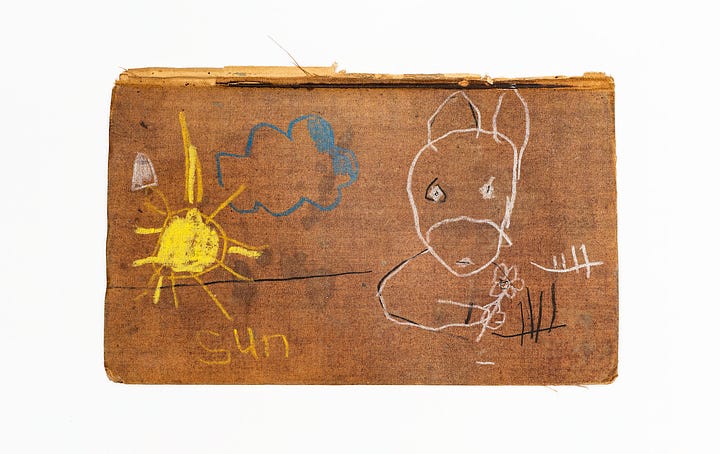
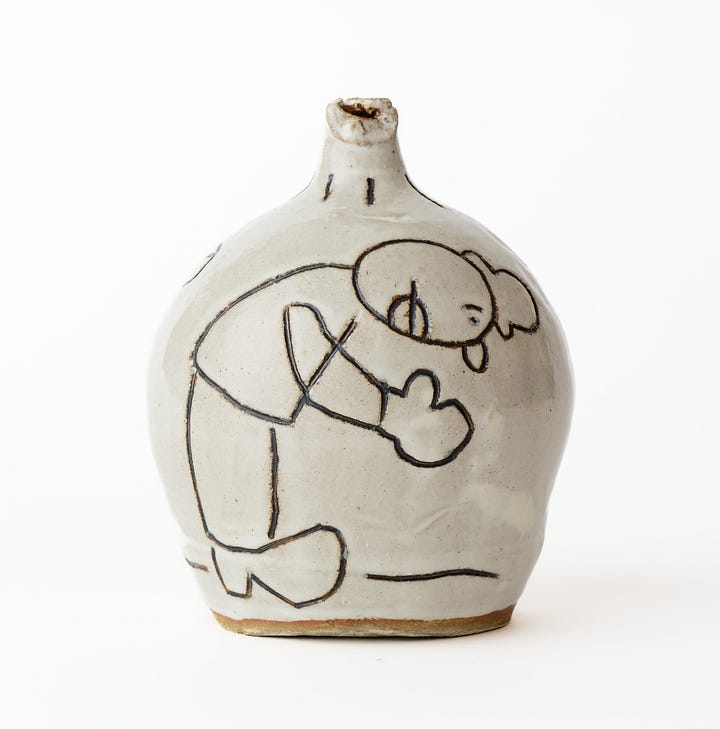
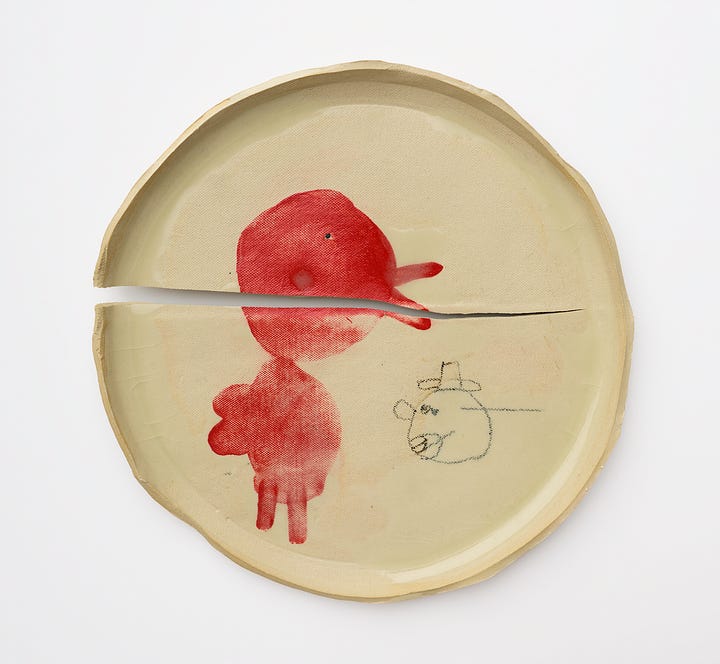
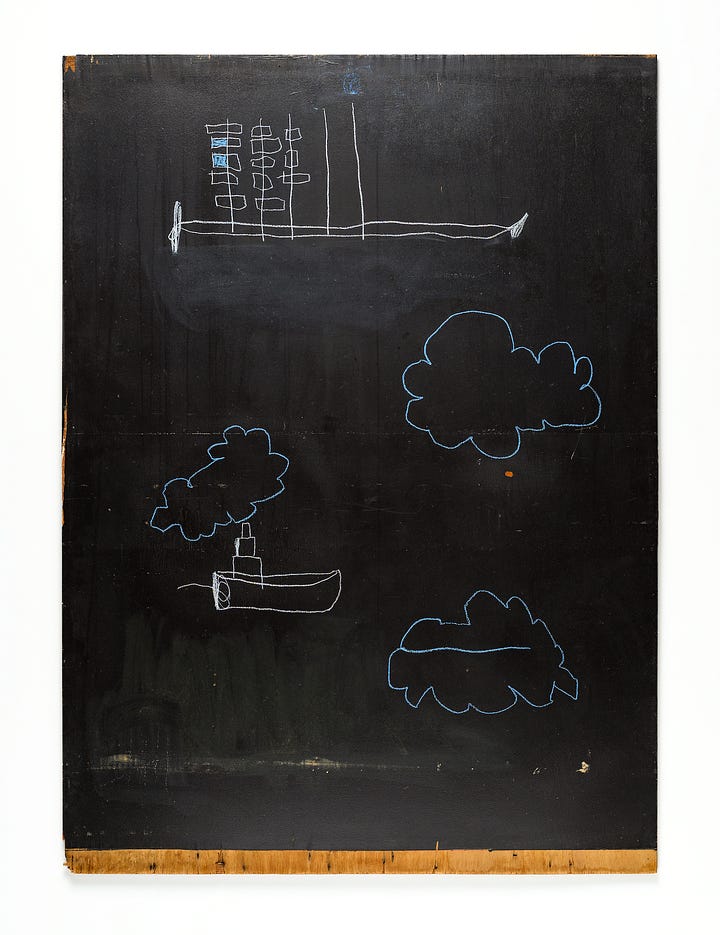
You often use unconventional materials as your canvases. What’s the significance behind that choice?
It’s a bit odd to think about now, but when I first began playing with drawing in my mid-twenties I started working on quite nice watercolor paper. I was a young actor in Los Angeles, California with a lot of time on my hands and as luck would have it a prior roommate where I was living had left behind oil and chalk pastels and some beautiful paper.
I worked on materials like this for many years, eventually finding my way to a paper supplier called Paper Source where I was drawn to their “as is” shelves of paper – this was beautiful and very expensive paper that was being sold at often a tenth of its original cost because of some blemish. Someone may have spilled coffee on an area, or a corner may have been bent or dented. In my work I was beginning to create backgrounds that seemed more like the paper was patinaed with age, so here I was being gifted aspects of “imperfect” material already.
Over time I was drawn towards wood that I would find in my neighborhood. An old gate or a dresser or cabinet that was being discarded – the commonality of the material was that it was always old and worn. I was searching for and was often given these sweet items with weathered surfaces to then add my characters to.
Old book covers and at times certain pages of these books became the next adventure. Then (music) record covers/sleeves and the odd, old, thick records themselves presented a surface to work on. Today I have numerous art friends who chuckle at the fact that almost anything is fair game for me as a surface.
My newest canvases are some of the discarded ceramic pieces that others have deemed either not functional or simply not good enough and throw into the community clay discard bucket. They suit me perfectly.
Your titles read like little stories. How important are tales in your creative process?
The tale or story of a piece often presents itself when the work is coming to completion or is finished. I don’t usually follow or see any narrative while working on a piece. Although I do feel that some part of me is listening, processing what is happening in my life and in the world around me and that is filtered into the work. In that sense the pieces are fairly autobiographical. And I’ll add that I don’t always understand or have a full grasp of the meaning of each piece.
I do enjoy giving pieces their titles. At times titles come quickly – when a specific character or characters that I’ve drawn or painted speak loudly to me or when the story does come forward. The titles often amuse me – I hope that they will amuse others as well.
You’re based in Austin, TX, but also represented in Sweden. How did that international collaboration come about?
Henning Hummerdal of Gallerie Hedenius in Stockholm had purchased a couple pieces of mine from Maya Frodeman Gallery in Jackson Hole, Wyoming. At some point Henning reached out to Maya to see if she thought I’d be interested in doing a show with him in Stockholm.
My memory is that Henning had heard about my work from a client of his who had an interest in my work.
I had a look at the gallery’s website, and I was intrigued and excited by the work that Henning was showing. And the gallery itself looked like a beautiful and interesting space.
Maya, Henning and I set up a time to talk. During that first conversation I feel that Henning and I connected quickly and his interest in the work was … well, it’s always nice to have a gallerist excited about your work so that was sweet. In the next couple conversations that Henning and I had he spoke about what drew him to my work and why he thought it was a good fit for Sweden. This clarity of vision for the work felt like it set up solid ground for the upcoming show and for the relationship in general. For both of us this was a sizable commitment – for Henning, in showing my work in Stockholm – and in showing an American artist. And for me in taking the risk of shipping the work to another country not knowing how it would be received.
I think we both clearly saw that we had a very similar way of seeing our individual responsibilities in the relationship. That we would both take care of our end of the “bargain” to make the show happen … and that in doing that we would take care of each other.
It has been a lovely experience working with Henning. We’ve now done a second show together and I look forward to continuing the relationship.
What’s the art scene like in Austin? Are there any artists in your community who inspire you?
Austin is a mixed bag – for a relatively small city with a quite large population, the art community is sizable and there are a good number of wonderful artists here. There are also a decent number of solid art galleries.
I feel that the art community itself is supportive – artists going out to shows, connecting with one another, passing on info, etc. But I don’t know that the pieces of the puzzle have come together to make this a real “art” town. (On a visit to Austin shortly before moving here in 2008 I met an artist who had been in Austin a long time and he said, “Austin is a great place to make art, it’s not a great place to sell art”. To be clear, I don’t think that “selling art” is a substantial measure of either a successful art career or of an art town …. Yet if a community is not supported in a city, it is challenging for that community to survive.)
Artists who inspire me:
I am inspired by a good number of artists in Austin. I find these artist’s work to be very alive, visually beautiful and deep … I’ll say up front that my descriptions or comments regarding the work will not do any of these artists justice.
Elizabeth Chiles makes stunning photographs of nature – often multiple images coming together to create a piece – that are deceiving in their simplicity – at first glance they may present as sweet landscapes or floral images, but are much more complex. The work is curiously and brilliantly evocative without screaming.
Beili Liu’s work concentrates mostly on installation pieces that evolve from a commentary on our effect on the world – whether it be climate change or the chaos and damage or beauty of our human-on-human interactions. Eventually when viewing Beili’s work I can put words to what I am seeing or how the work makes me feel, but initially I am often in a freefall of emotion.
Tammie Rubin’s work to me is solid and grounded yet also somehow manages to be quite ethereal. Her work is often two things at once - simple and visually beautiful while having the ability contextually to wake you up.
What’s coming up for you next?
I have a solo exhibition up currently (August/September 2025) at grayDuck Gallery here in Austin. This was my second time working with Jill Schroeder, the gallerist. The gallery space is a bit unusual in shape, so it lends itself to some interesting and fun possibilities for displaying/presenting the work. I’m showing a good amount of the ceramic work – this is only my second time to show the ceramic work and the first time to show it here in the US. So that is exciting.
Then it’s back to my studio and the ceramic studio to continue my practice.
Thank you Tucker for the conversation! To find out more about Tucker’s work, you can visit the following websites:
wtucker-art.com
lightbeforelightbehindme@tumblr.com https://conduitgallery.com/exhibitions/compassion-said-the-rabbit https://www.mayafrodemangallery.com/artists/60-w.-tucker/works/ https://koelschgallery.com/artist/w-tucker/,https://www.gallerihedenius.com/w-tucker-this-i-found


